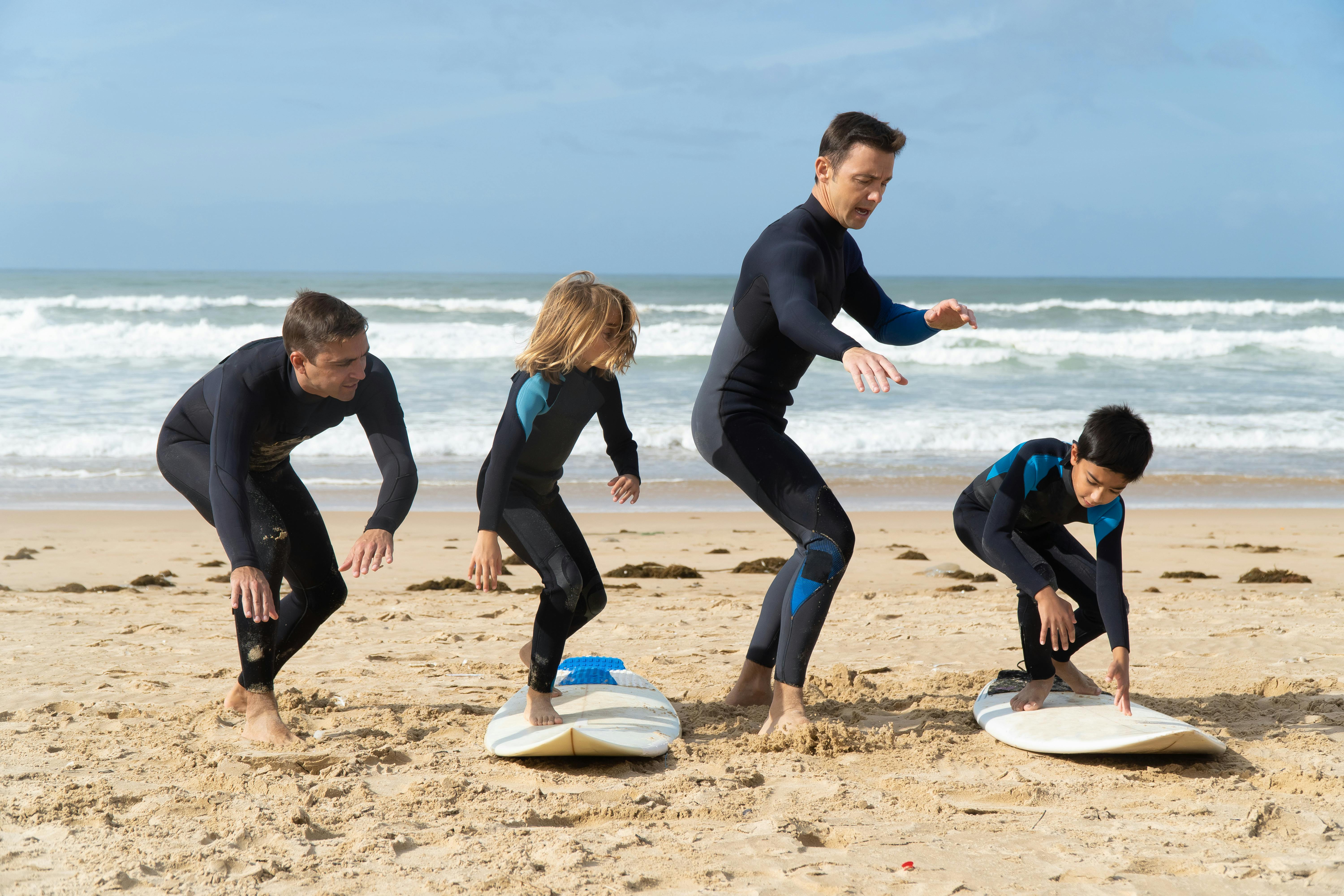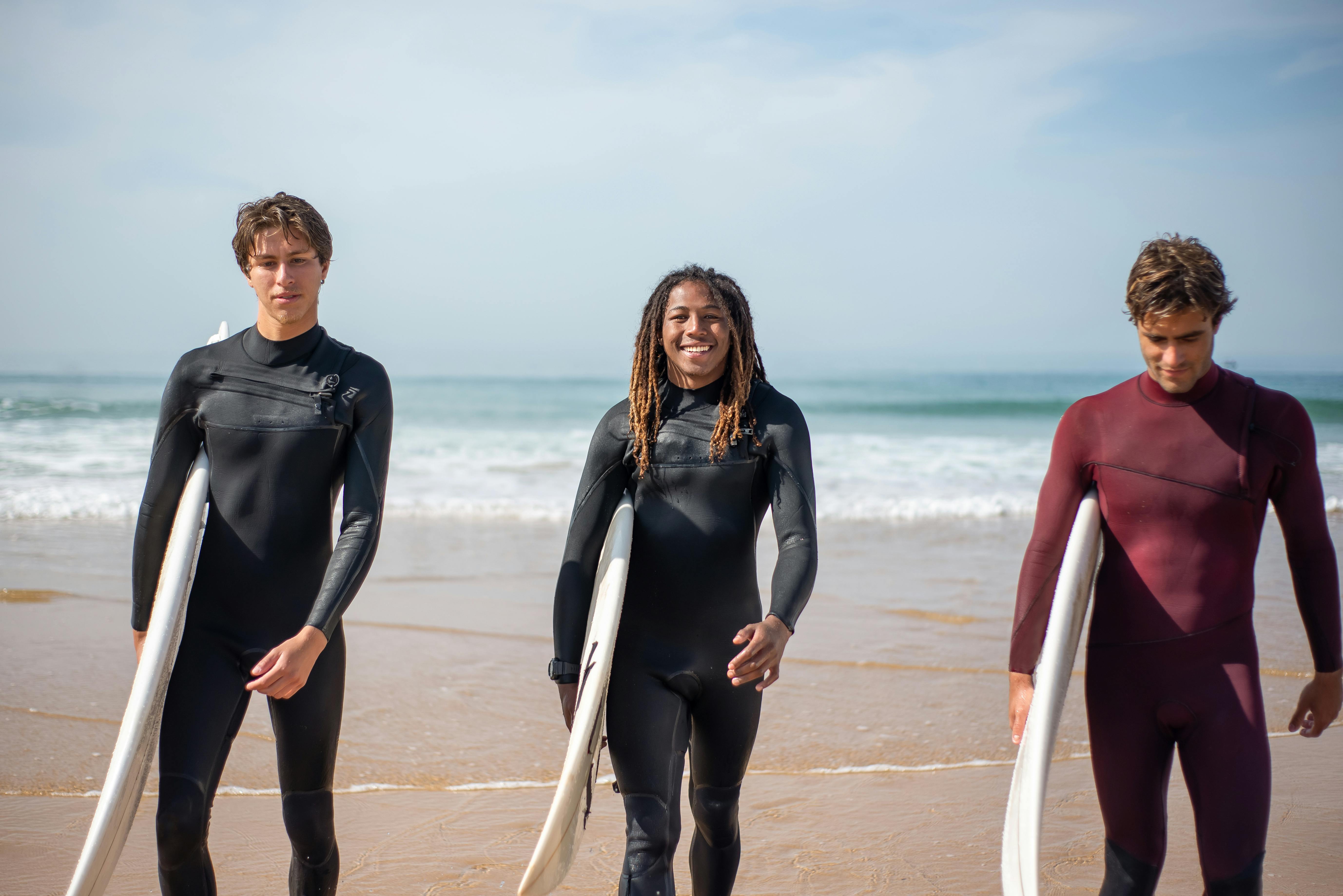Why Do Surfers Wear Wetsuits

Surfing is a popular sport that can be enjoyed year-round. However, in order to stay safe and comfortable while surfing, it is important to wear the right gear and apparel. One of the most essential items for any surfer is a wetsuit. Wetsuits provide warmth and protection from the elements, making them an essential piece of equipment for surfers of all levels. In this article, we will discuss why surfers wear wetsuits and the different types available.A wetsuit is a piece of clothing designed to be worn while swimming or engaging in water sports such as surfing, snorkeling, and scuba diving. It is made of a thin neoprene material that provides insulation to keep the wearer warm in cold water. Wetsuits are usually made with either full-body coverage or shorts and a top. They are typically held together with zippers or velcro closures, and some even feature protective padding for extra protection.
Why Do Surfers Wear Wetsuits?
Surfers wear wetsuits for a variety of reasons, including warmth, protection, and buoyancy. The most important reason is to keep warm in cold water temperatures. Wetsuits are designed with neoprene material that traps a layer of water between the body and the suit. This water is then heated by body heat so that the surfer can remain comfortable in colder temperatures.
Wetsuits also provide protection from abrasions, stings, cuts, and jellyfish stings when out in the ocean surfing. The neoprene material is durable and resilient enough to protect against sharp objects such as coral and rocks in shallow waters. This makes surfing more enjoyable as there are less worries about potential injuries while out on the waves.
Lastly, wetsuits provide buoyancy which helps surfers stay afloat in the water while also providing added protection against strong currents or waves. The neoprene material used in wetsuits is naturally buoyant which helps to keep surfers afloat and gives them an advantage when paddling out to catch a wave.
In conclusion, surfers wear wetsuits for warmth, protection, and buoyancy while they are out enjoying some time on the waves. The neoprene material used in these suits helps keep surfers warm and safe from potential injuries or strong currents that may occur while out at sea.
Advantages of Wearing a Wetsuit
Wearing a wetsuit has numerous advantages for those who enjoy spending time in the water. Whether you are a recreational swimmer or an experienced surfer, there are many benefits to wearing a wetsuit. The main advantages include increased warmth, protection from the elements, and improved buoyancy.
Wearing a wetsuit provides much needed insulation from the cold waters of the ocean. This is especially important for those who spend extended amounts of time swimming or surfing in colder climates. The wetsuits are designed to trap body heat, creating an insulating layer between your body and the cold water. This helps keep you warm and comfortable while you enjoy your aquatic pursuits.
In addition to keeping you warm, wetsuits also provide protection from various elements in the environment such as rocks, debris, and even dangerous marine life. The material used to make these suits is very durable and resistant to wear and tear. This means that it can provide ample protection against impacts from sharp objects or aggressive marine life.
Finally, wearing a wetsuit can significantly improve your buoyancy while swimming in the ocean. Since these suits are designed to trap air bubbles close to your body, they help keep you afloat even when submerged underwater. This allows you to swim with greater ease and less fatigue which is especially beneficial for recreational swimmers or those learning how to surf.
In conclusion, wearing a wetsuit has many advantages for those who spend time in the water. It provides excellent insulation against cold temperatures as well as protection against harmful elements in the environment. Additionally, it improves your buoyancy while swimming or surfing which can make aquatic activities more enjoyable and less exhausting.
Different Types of Wetsuits
Wetsuits are a great way to stay warm and active while enjoying water activities. They come in a variety of styles, materials, and sizes to suit any need. From full-body wetsuits designed for deep sea diving to shorty wetsuits for warmer climates, there is a style to fit every person’s needs. Here is an overview of the different types of wetsuits available:
Full-Body Wetsuit: Full-body wetsuits are designed for cold water temperatures and provide the most coverage. They typically have long sleeves and legs, as well as a hood that covers the head and neck. This type of wetsuit is ideal for deep sea diving or cold weather swimming.
Shorty Wetsuit: Shorty wetsuits are designed for warmer climates and provide minimal coverage. They typically have short sleeves and legs, with no hood. This type of wetsuit is ideal for snorkeling or swimming in mild conditions.
Farmer John Wetsuit: Farmer John wetsuits are similar to full-body suits but feature extra fabric around the thighs and waist area for extra warmth and flexibility. This type of wetsuit is ideal for surfing or other water activities where extra mobility is needed.
Semi-Dry Wetsuit: Semi-dry wetsuits are designed with thicker neoprene material than regular full-body suits, making them more water resistant. They typically have sealed seams, wrist seals, ankle seals, as well as a built-in hood to keep water out better than other full suits. This type of suit is ideal for cold weather scuba diving or other extreme water activities.
Rash Guard: Rash guards are made from lightweight Lycra material that helps protect your skin from chafing and sunburns while in the water. They provide some insulation from cold temperatures but are not as warm as other types of suits. Rash guards can be worn alone or under another suit for extra warmth.
Spring Suit: Spring suits are similar to shorty suits but offer more coverage than just shorts alone. They usually have long sleeves or legs with some extra fabric around the torso area, giving them more insulation than traditional shorty suits. This type of suit is ideal for swimming in cooler temperatures or when you need some extra coverage from the sun’s rays.
These are just some of the different types of wetsuites available on the market today. Be sure to consider your needs before buying one so you can find a style that fits you best!
Fit
Finding the right fit for your wetsuit is essential. A wetsuit should be snug but not too tight, allowing you to move freely in the water. Make sure that you try on several different sizes and styles to ensure that you find the best fit for your body type. Additionally, make sure you leave enough room for any additional layers you may need to wear underneath your wetsuit.
Materials
The material of your wetsuit is also important. Traditional neoprene wetsuits provide insulation and protection from the elements, while modern materials such as lycra or polypro are lighter and more flexible. Consider the conditions in which you will be using your wetsuit and select a material that is suitable for those conditions.
Style
The style of your wetsuit should also be taken into consideration. There are a variety of different styles available, ranging from full-length bodysuits to shorty suits and even one-piece swimsuits. Consider the activities you will be engaging in when selecting a style that is right for you.
Durability
Durability is another important factor to consider when choosing a wetsuit. Make sure that the material and construction of your wetsuit are designed to withstand rigorous use and exposure to salt water or chlorine. Pay attention to details such as seams, zippers, and closures to ensure that your suit is built to last.
Price
Finally, price should also be taken into consideration when selecting a wetsuit. Wetsuits range in price from budget-friendly options to more expensive premium suits with advanced features. Consider how often you plan on using your suit and choose one that fits within your budget while still providing the features you need.<

Cold Water Surfing
Cold water surfing is a thrilling activity that requires a great deal of preparation and the right gear. The first thing you will need to know is the temperature of the water. Cold water temperatures can range from below zero in some areas to around ten degrees Celsius or fifty degrees Fahrenheit in others. Knowing the exact temperature of the water you plan to surf in is essential for selecting the right wetsuit and other gear. It’s important to note that cold water temperatures can vary significantly even within a given area, so it’s best to check your local weather report before heading out.
Wetsuit Temperature Ratings
The best way to determine the type of wetsuit you need for cold water surfing is by looking at its temperature ratings. Wetsuits come with different temperature ratings, ranging from lightweight summer suits designed for warmer waters up to heavy-duty winter suits made for cold waters. Generally speaking, a lightweight summer suit may be sufficient for waters around ten degrees Celsius, while a winter suit may be better suited for temperatures below five degrees Celsius. It’s important to remember that these temperature ratings are only guidelines and you should always factor in your own comfort level before making a purchase.
Warm Water Surfing
Surfing is a great way to get out on the water and enjoy the ocean. Although surfing can be cold at times, warm water surfing is ideal for those seeking a more comfortable experience. Warm water surfing offers an enjoyable and relaxing session in the ocean with temperatures ranging from 70-80 degrees Fahrenheit. Warm waters make it easy to stay in the water for longer periods of time without having to worry about getting cold or uncomfortable. The waves in warmer waters are typically smaller, making them ideal for beginner surfers who are just starting out.
UV Protection
It is important to protect your skin from harmful UV rays while enjoying any outdoor activity, including surfing. Applying sunscreen with a minimum SPF of 30 before heading out into the sun and re-applying it every two hours is key for preventing sunburns and other damage caused by overexposure to UV rays. Wearing protective clothing such as rash guards and hats can also provide additional protection from the sun’s rays. Additionally, wearing sunglasses can help protect your eyes from UV radiation while you are surfing or enjoying other water sports activities.
Overall, warm water surfing can be a great way to relax on the beach while also staying safe from the sun’s UV rays. With the right preparation and precautions, you can enjoy all that warm water surfing has to offer without worrying about getting too cold or getting hurt by the sun’s rays.
Different Styles of Wetsuits for Surfing
Wetsuits are essential garments for surfing. By trapping a thin layer of water between your skin and the suit, wetsuits provide insulation from the cold ocean temperatures and also provide protection from sunburn and stings. There are a variety of different styles of wetsuits available to suit different needs, from full-length suits designed for surfers who spend long hours in the water to shorty suits designed for warmer climates. Here’s a look at some of the most common types of wetsuits:
Fullsuits: Fullsuits cover the entire body from neck to ankles and wrists, providing maximum protection from the cold. They are usually made of neoprene, which is a synthetic rubber material that is flexible and durable. Fullsuits come in a variety of thicknesses depending on the temperature you will be surfing in — thicker suits provide more insulation, while thinner suits will keep you warm without restricting your movement. Most fullsuits also include features such as glued-in seams and waterproof zippers to keep out water.
Springsuits: Springsuits offer more flexibility than fullsuits but still provide warmth and protection against sunburns. These suits typically have short sleeves and legs that come down to mid-thigh or knee length. Springsuits can be made with either full or partial neoprene panels, depending on how much warmth you need.
Shorty Suits: Shorty suits are ideal for warmer climates or when you don’t need as much warmth. These suits typically go up to just below the elbows and knees, making them easy to move around in without sacrificing too much warmth. They usually have full neoprene construction but can also be made with partial neoprene panels.
Rashguards: Rashguards are not technically wetsuits but they do provide some protection against sunburns as well as stings from jellyfish or other sea creatures. Rashguards are usually made from nylon or spandex and fit like T-shirts or tank tops — they can be worn on their own or underneath other wetsuit styles for added warmth.
No matter which type of wetsuit you choose, make sure it fits properly so that it can do its job effectively — if it’s too big it won’t keep you warm; if it’s too small it won’t allow for comfortable movement while you’re surfing. With so many different styles out there, there’s sure to be one that works perfectly for your needs!

Conclusion
Overall, the use of wetsuits by surfers is invaluable for a comfortable and enjoyable surfing experience. Not only do they provide warmth in cold waters, but also protect from abrasions and jellyfish stings. In addition to this, they are also known to help improve a surfer’s performance on the water by providing buoyancy and flexibility. With all of the benefits that wetsuits offer surfers, it is no wonder why they are so widely used in the sport.
Overall, wetsuits have become an essential part of surfing for many people who enjoy the sport. They are comfortable, flexible and can help increase performance while keeping you warm during long sessions on cooler days. Additionally, they provide excellent protection from both abrasions and jellyfish stings. With all these advantages, it is easy to see why more and more surfers are relying on wetsuits as a key part of their surfing gear.
